Let’s discuss about what Companies are in The Public Utilities Field?
American Electric Power
Headquartered in Columbus, Ohio, and boasting assets exceeding $39 billion, AEP serves residential, commercial, and industrial customers across the Midwest and Southeast regions. With an employee base nearing 20,000, AEP dedicates itself to delivering high-quality service and pioneering energy solutions.
Guided by a mission to “enhance the quality of life of our customers, shareholders, and employees,” AEP focuses on providing safe, reliable, and competitively priced electricity and gas services. The company places a strong emphasis on environmental stewardship and economic development, evident in its commitment to sustainability.
AEP’s forward-looking initiatives underscore its dedication to a sustainable future. In 2019, the company unveiled an ambitious target to slash carbon emissions by 80% before 2050. Furthermore, AEP recently disclosed a $4 billion investment plan in solar and wind projects by 2024.
As a prominent example of a large public utilities company, AEP stands out for its unwavering commitment to reliable service provision alongside a proactive approach to environmental responsibility. Through their sustainability endeavors, AEP serves as a model for other public utilities companies aspiring to integrate eco-friendly practices into their operations.
CenterPoint Energy

Based in Houston and with supplementary offices in Chicago, Dallas, Jackson, Memphis, Atlanta, Orlando, Tampa Bay Area, Los Angeles, and the San Francisco Bay Area, CenterPoint Energy is a company that goes beyond traditional utility services. With over 15 thousand miles of pipeline extending across 38 states, the company offers a diverse range of energy solutions to its customers.
CenterPoint Energy is not just a provider of essential services; it also takes a proactive approach to help customers manage and reduce their energy costs. The company offers an array of energy efficiency programs, energy management services, and various rebates and incentives. This comprehensive approach underscores CenterPoint Energy’s commitment to providing value beyond basic utility services and contributing to the sustainable and efficient use of energy resources.
Duke Energy
Established in 1888 by James Boon Duke with the acquisition of a small gas system, Duke Energy has evolved into a major player in the energy sector. The company’s comprehensive services encompass electricity generation, power transmission and distribution, natural gas delivery, and energy efficiency solutions. With a formidable net electric generating capacity exceeding 40,000 megawatts, Duke Energy stands as one of the largest energy companies in the United States.
Duke Energy operates globally, with a footprint extending to Latin America and Europe. Over the years, the company has expanded through strategic mergers, such as the notable union with Progress Energy in 2012. This merger added nearly five million customers to Duke Energy’s clientele.
Progress Energy, before merging with Duke, made substantial investments in solar power generation. However, post-merger, Duke Energy has shifted its focus toward cleaner energy sources, emphasizing natural gas and renewables that produce fewer emissions compared to coal or oil-fired plants. The company anticipates significant growth in renewable energy, with plans to install approximately 900 megawatts by 2019, effectively doubling its existing renewable portfolio.
As part of its commitment to sustainability, Duke Energy operates an 82-megawatt solar facility at Fort Drum in upstate New York. This facility not only supports critical defense needs but also provides clean power to approximately 10% of the population in their service territory. Duke Energy’s evolution reflects a dedication to adapting and advancing in the dynamic landscape of the energy industry.
Dominion Resources
Dominion, a prominent player in the public utilities sector, boasts ownership and operation of an extensive network, including over 18,000 miles of transmission lines. With a robust presence, the company serves more than 11 million retail customers spanning 16 states. Dominion has positioned itself as a leader in renewable energy, with substantial investments in wind, solar, and hydroelectric power, showcasing a long-standing commitment to sustainable practices.
Beyond its core business functions, Dominion is actively engaged in various facets of the public utilities landscape. The company holds significant stakes in nuclear energy, overseeing operations at notable facilities like the North Anna Power Station and the Surry Nuclear Power Plant in Virginia, as well as the Millstone Power Station in Connecticut. Dominion’s influence extends further through its management of an extensive pipeline network, facilitating the transportation of natural gas, liquid natural gas, and crude oil across the United States.
As a comprehensive entity in the public utilities field, Dominion Resources is a driving force, consistently channeling significant investments into renewable energy sources. This strategic approach ensures the ongoing delivery of reliable power to their expansive customer base across the serviced regions.




